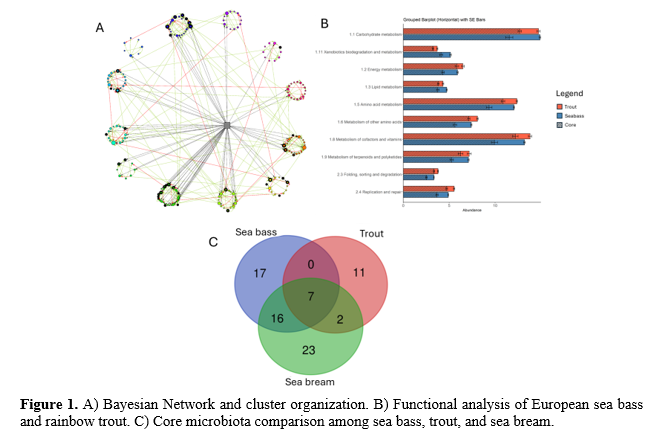ONE FUNCTION, MANY FACES: A MULTI-SPECIES DIVE INTO THE FUNCTIONAL CORE OF FISH GUT MICROBIOMES
Introduction
Among the microbiomes closely associated with animals, the intestinal populations represent the most abundant and biodiverse. This microbial association is also characterized by a strong inter and intra-species variability, which however came with a high functional redundancy. These two aspects together make the investigation and the prediction of the microbiota modification an ongoing challenge (Vatsos, 2017). Therefore, the definition of feasible microbial biomarkers and the understanding of the inner bacterial relationships are particularly relevant in the context of aquaculture sector, as it is broadly documented how microbiota can impact the performance and the welfare of farmed animals (Luan et al., 2023). Hence, the aim of the present study was to find similarities and differences in the gut microbial populations of three main European farmed fish (gilthead sea bream, European sea bass, rainbow trout) with focus on the functional role of the core microbiota species using a computational and Bayesian network approach .
Materials and Methods
The present study was conducted using a total of seven intestinal microbiota datasets, four for European sea bass (Dicentrarchus labrax), three for rainbow trout (Oncorhynchus mykiss ), and an additional meta-analysis sea bream (Sparus aurata) data taken from (Moroni et al., 2025). The considered bacterial profiles have been obtained from different feeding trials focused on the effects of partial substitution of fish meal and fish oil with innovative and alternative feed ingredients. The different microbiota results were used to construct a hierarchical and stochastic Bayesian network (BN) to identify the relationships within the populations and the role of the core microbiota fraction previously identified. Functional characterization of the microbiota was performed using a cluster-based approach , identifying densely connected nodes and inferring their functional contribution using PICRUSt2 protocol (KEGG) . Multi-species final comparison was performed using a Partial-Least Square Discriminant Analysis (PLS-DA).
Results and Discussion
For all the fish species analysed, feed composition and genetic represent the main driving factors , which modulate and change the intestinal microbiota composition. Despite this variability, a reduced number of bacteria , which however represent the most abundant fraction, has been identified as core. In particular, sea bass showed a total of 40 bacteria, while trout only 23. The BN construction allowed the identification of the stochastic structure of the bacterial population for each fish species , and the hierarchical role of core microbiota, highly distributed within the community (Fig. 1A) . The importance of this microbial fraction was also confirmed by the inferred functional analysis , as t he metabolic profiles of the core-associated clusters played as principal actors in all the pathways identified (Fig. 1B). The results also highlighted that European sea bass and rainbow trout shared similar metabolic routes, but carried out by distinct bacterial communities, confirm ing that within a strong functional redundancy, the two farmed species presented a completely separate intestinal microbial organization . Furthermore, the importance of the core microbiota as feasible specific signature was also confirmed from an ecological and evolutionary perspective. In fact, the introduction of the gilthead sea bream microbiota profile in the analysis clearly indicated a stronger similarity with European sea bass, confirming that genetic background and environmental factors play a pivotal role in the shaping of the intestinal microbiota (Fig. 1C) . These results finally allowed the identification of bacterial markers specific to the two phenotypes, functionally determining and belonging to the core fraction.
Concluding remarks
This study demonstrates the potential of a functionally core microbiota driven approach to identify bacterial biomarkers that not only reflect taxonomic signatures but also reveal deeper ecological phenotypes . Ultimately, these results provide a valuable tool for monitoring intestinal health status, welfare assessment and defining more sustainable production strategies for numerous aquaculture species.
Funding
This work was supported by the TNA programme (PID24876) within H2020 AQUAEXCEL3.0 project , and by MCIN with funding from European Union NextGenerationEU (PRTR-C17.I1) and by Generalitat Valenciana (THINKINAZUL/2021/024).
References
Luan, Y. et al. (2023). Engineering , Vol. 29, pp. 137–146 ;
Moroni, F. Et al. (2025). Microorganisms, 13(1), 198 ,
Vatsos, I. N. (2017). Laboratory Animals , Vol. 51, Issue 4, pp. 353–364.
